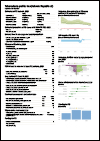What's New
Displaying results 171 - 180 of 4911

Resource | Fact Sheets,
In August 2022, there were 1,346 confirmed HIV-positive individuals reported to the HIV/AIDS & ART Registry of the Philippines (HARP) and were accounted to the total (104,458) reported cases since January 1984. Moreover, 368 (27%) of individuals reported in August had advanced HIV infection at the time of diagnosis. Two hundred twenty deaths were newly reported, bringing the total deaths this year to 541.

Resource | Reviews and Snapshots,
Tuberculosis profiles are generated automatically based on data reported by countries and which are held in WHO's global TB database. The document includes data for estimates of TB burden, UHC and social protection, TB/HIV care in new and relapse TB patients, drug-resistant TB care in the country.

Resource | Publications,
UNDP’s Strategic Plan 2022–2025 and HIV and Health Strategy 2022-2025 view open and inclusive civic spaces as central to achieving broader structural changes to build resilient societies able to respond to conflicts and crises and ensuring that no one is left behind.

Resource | Publications,
This issue brief shares lessons and reflections on enabling legal environments, including decriminalisation, to inform the implementation of key commitments in the 2021 Political Declaration on HIV and AIDS and the Global AIDS Strategy. These include a shared understanding of the harms caused by the overly broad and unjust application of criminal laws; sensitization of key stakeholders and their engagement in legal review processes; A well-informed judiciary; Coordinated, multi-pronged and multisectoral legal advocacy; and, global and regional advocacy to advance national-level changes to HIV-related punitive and discriminatory laws, including decriminalization.

Resource | Publications,
This issue brief shares lessons and reflections on the role of the judiciary in advancing rights-based HIV responses, to inform the implementation of key commitments in the 2021 Political Declaration on HIV and AIDS and the Global AIDS Strategy. These include an understanding of the critical nature of judicial decisions in shaping the HIV-related legal environment; the important legal implications of evolving HIV science; sensitizing judges to people’s lived experiences is key; and safe spaces for respectful discussion and learning among justice sector peers.

Resource | Publications,
This issue brief shares lessons and reflections on the importance of regional spaces for strengthening responses, to inform the implementation of key commitments in the Political Declaration on HIV and AIDS and the Global AIDS Strategy. These include an appreciation that convening stakeholders in regional spaces can be safer than in national spaces; regional-level discussions can foster peer-to-peer knowledge exchanges; regional level networking can lead to a network of in-country allies; and importance of regional economic communities for aligning national HIV-related laws with human rights commitments.

Resource | Publications,
This issue brief shares lessons and reflections on the importance of safe and open civic space for advancing rights-based HIV responses and informing the implementation of key commitments in the 2021 Political Declaration on HIV and AIDS and the Global AIDS Strategy. These include an understanding that early and broad engagement helps to facilitate the buy-in of key and diverse stakeholders; creating and maintaining safe, open and enabling spaces is critical for civil society to fully contribute to the HIV response; the relationships between governments and civil society are complex and require careful navigation; and capacity strengthening and sensitization of stakeholders is needed for meaningful engagement.

Resource | Fact Sheets,
Each year the annual estimates of key indicators among people living with HIV in Nepal are finalized by using AIDS Epidemic Model and Spectrum/AIM. Various survey and research data (key population size, Nepal Demographic Health Survey, trends of prevalence and behavioral data from integrated biological and behavioral surveillance surveys, behavioral information on condom use, sexual behavior, injecting practice, number of clients etc.) and program data like people on ART and PMTCT data are used as input in the analytical tools to prepare annual estimates of the status of the HIV epidemic in Nepal. The HIV epidemic in Nepal remains largely concentrated among key populations (people who inject drugs, sex workers and their clients, men who have sex with men and transgender people, male labour migrants and their wives and prison inmates).

Resource | Publications,
This document summarizes the results of the WHO-commissioned full value proposition for new tuberculosis (TB) vaccines. The assessment was commissioned to provide early evidence for national and global decision-makers involved in TB vaccine development and implementation, who include stakeholders involved in vaccine research, financing, regulation and policy-making, manufacturing, introduction and procurement. The goal is to accelerate development of effective vaccines against TB and their rapid introduction into countries.

Resource | Publications,
This guidance is intended to help policymakers develop survivor-centered programming on ending violence against women and girls that meets the needs of diverse groups of women and girls, including those who are at higher risk of experiencing violence and discrimination. It is applicable to programming across the health, justice and policing, and social services sectors, as well as coordination of these sectors, and will help improve the standard and delivery of essential services for women and girls who have experienced violence.





